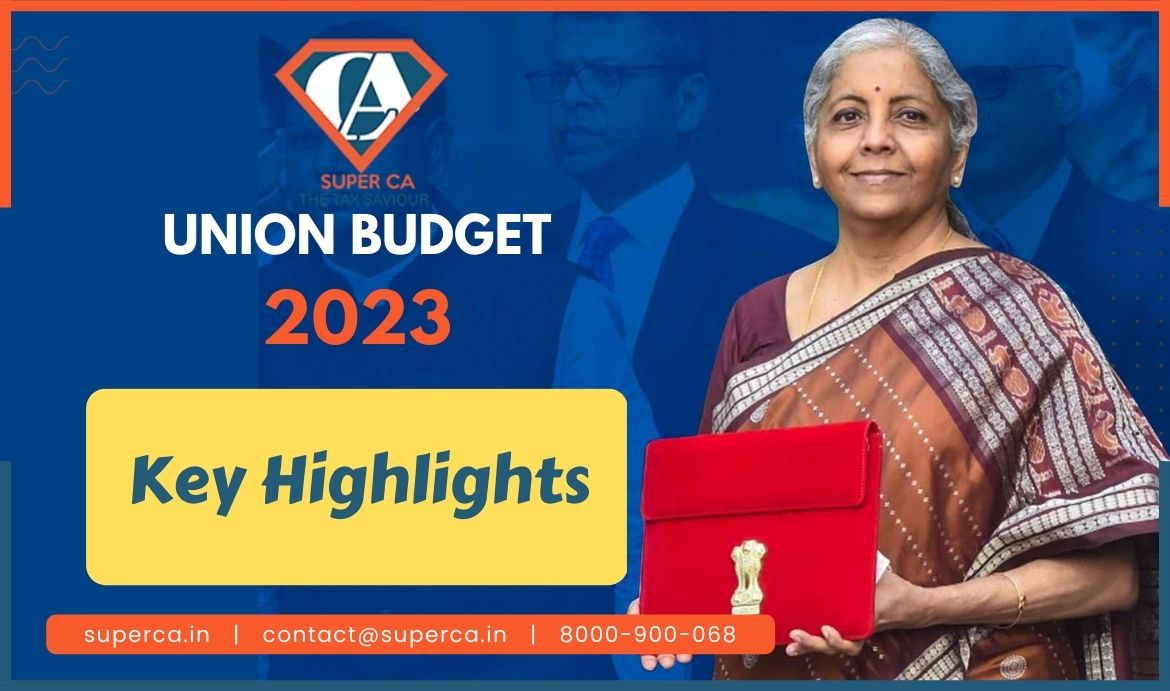
About
In the financial year 2022-23, India saw a 25% increase in direct tax collections compared to the previous year. This growth is attributed to government reforms. The recent Budget 2023 had high expectations from both the salaried class and corporations. The Finance Minister announced seven priorities, including infrastructure, digitization, and inclusive development, and proposed a 33% higher capital expenditure of INR 10 lakh crores compared to last year. The focus was also on promoting AI, streamlining KYC processes, and digitization. The highlight of the Budget was the introduction of new tax reliefs for individuals and a shift towards the new tax regime. The government aims to provide higher tax incentives for investment and insurance through deductions under section 80C. Here are some key amendments proposed by the Budget for individuals.
Key Proposals Made
Indirect Tax Proposals
➤ Minister of Finance and Corporate Affairs, Nirmala Sitharaman, outlined indirect tax proposals in the 2023 Budget with a focus on streamlining the tax system and reducing compliance costs.
➤ She reduced the number of basic customs duties on goods from 21 to 13, except for textiles and agriculture, and made minor adjustments to duties, cesses, and surcharges on items such as toys, bikes, cars, and naphtha.
➤ The excise duty on blended compressed natural gas was waived to prevent tax cascading.
➤ The import of specified capital goods and machinery for the production of lithium-ion cells in EV batteries will remain exempt until 2024.
➤ Vehicles, auto parts, and components can be exempt from customs duty for testing and certification by approved agencies.
➤ The budget also cut customs duties on certain phone components and camera lenses to boost domestic production.
➤ The customs duty on electric kitchen chimneys was raised to correct the inverted duty structure and promote local production.
➤ The duty on heat coils used in kitchen chimneys was reduced, while denatured ethyl alcohol became duty-free.
➤ The customs duty on some minerals, seeds, and inputs was reduced, while that on silver jewelry was raised to match gold and platinum.
➤ The customs duty exemption on raw materials for CRGO steel, ferrous scrap, and nickel cathode was maintained, as was the 2.5% duty on copper scrap.
➤ The duty rate on compounded rubber was increased from 10% or Rs. 30 per kg to 25%.
➤ The National Calamity Contingent Duty on certain cigarettes was raised by 16%.
Direct Tax Proposals
Personal Income Tax
The 2023 Union Budget introduced alterations to the income tax slabs under the new tax regime. The basic exemption limit was raised from INR 2.5 lakh to INR 3 lakh. The number of income tax slabs was also reduced from 6 to 5. The rebate under Section 87A was increased from INR 5 lakh to INR 7 lakh, meaning individuals earning up to INR 7 lakh are exempt from paying taxes.
| Total Income (Rs) | Rate (per cent) |
| Up to 3,00,000 | Nil |
| From 3,00,001 to 6,00,000 | 5 |
| From 6,00,001 to 9,00,000 | 10 |
| From 9,00,001 to 12,00,000 | 15 |
| From 12,00,001 to 15,00,000 | 20 |
| Above 15,00,000 | 30 |
➤ The new tax regime features a reduction in the surcharge for the highest tax rate from 37% to 25%. This new regime is the default option, however, individuals can choose to stick with the old regime. The purpose of introducing the new regime is to relieve compliance pressure for salaried taxpayers and offer lower tax rates compared to the old regime, while still providing benefits such as deductions and exemptions.
➤ In Budget 202 introduced measures aimed at simplifying the tax structure and improving the tax administration process for taxpayers. One such measure was the introduction of a new “Common Income Tax Return (ITR) Form” for easier tax filing.
➤ The Minister also announced the strengthening of the direct tax grievance redressal mechanism by deploying 100 Joint Commissioners and being more selective in accepting cases for review.
➤ Additionally, the limit for tax rebate under section 87A was increased from Rs. 5 lac to Rs. 7 lac, making individuals earning up to that amount exempt from paying tax.
➤ Salaried individuals will receive a standard deduction of Rs. 50,000.
➤ Micro enterprises and certain professionals will have higher limits for presumptive taxation and new co-operatives will have a tax rate of 15%.
➤ Sugar cooperatives will be able to claim payments made to sugarcane farmers and start-ups will have extended incorporation date for tax benefits.
➤ Capital gains deductions on residential house investments will be capped at Rs. 10 crore and the minimum TDS threshold will be removed.
➤ TDS rate on EPF withdrawal will be reduced to 20% and Joint Commissioners will be deployed to handle small appeals.
➤ Losses from strategic disinvestments and payments from Agniveer Corpus Fund will be tax exempt.
Sector Specific Proposals
Capex
The 2023-24 Union Budget presented by Finance Minister Nirmala Sitharaman places a strong emphasis on boosting capital expenditure, with a 33% hike to INR 10 lakh crore. The goal is to create job opportunities for the youth and jumpstart economic growth post-COVID-19.
To aid the states, the government extended a long-term loan of INR 1.3 trillion for longer-term investments. The increase in capital expenditures this year, while slightly lower than last year’s 35% jump, remains substantial. The capital expenditure to GDP ratio is anticipated to rise to 3.3% in the coming financial year, up from 2.7% in the previous year.
Finance
The Union Budget for FY 2022-23 focuses on four key priorities: PM GatiShakti, Inclusive Development, Productivity Enhancement & Investment, Sunrise opportunities, Energy Transition, and Climate Action, Financing of Investments.
The budget’s goal is to grant more financial flexibility to states and has therefore raised the allocation for the “Scheme for Financial Assistance to States for Capital Investment” from INR 10,000 crore to INR 15,000 crore in the revised estimates for the current year.
Railways
The Union Budget 2023-24, presented by Union Finance Minister Nirmala Sitharaman, has set aside a substantial sum for the Indian Railways, with a capital outlay of INR 2.40 lakh crore, the largest in its history. This allocation, which is nearly nine times the outlay made in 2013-14, demonstrates the government’s commitment to enhancing the country’s railway system. The railway sector has undergone significant improvements in recent years, and the capital expenditures are expected to continue to grow. This growth will help the railway system become a catalyst for national growth and development. The government aims to attract private investment in railway infrastructure and will do so with the help of the newly established Infrastructure Finance Secretariat, which will support all infrastructure-related sectors including railways, roads, urban development, and power. The allocation of INR 2.40 lakh crore for the Indian Railways in the Union Budget 2023-24 is a major step forward in the development of the country’s railway system, and will greatly improve infrastructure, services, and the overall experience for passengers and stakeholders.
Real Estate
The Union Budget 2023-24, presented by the Union Finance Minister Nirmala Sitharaman, put an emphasis on developing the nation’s infrastructure and real estate. Key highlights for these sectors include:
- Boosting the PM Awas Yojana budget by 66% to over INR 79,000 crore.
- Limiting the deduction from capital gains on residential property investment under sections 54 and 54F to INR 10 crore and restricting the income tax exemption from insurance policy revenues.
- Altering the capital gains calculation guidelines in joint property development to include payment received.
- Allowing interest paid on borrowed capital for property acquisition or improvement to be claimed as a deduction and included in the cost of acquisition/improvement on transfer to lower capital gains, but excluding the amount of interest claimed as a deduction from the cost.
- Amending the rules for calculating capital gains in joint property development to incorporate consideration paid.
- Urging cities to improve their creditworthiness for municipal bonds through property tax governance reforms and separating user charges on urban infrastructure.
- Establishing the Urban Infrastructure Development Fund (UIDF) managed by the National Housing Bank to construct urban infrastructure in Tier 2 and Tier 3 cities, funded through priority sector lending and with states encouraged to use resources from the 15th Finance Commission grants and existing schemes. The government plans to make INR 10,000 crore available annually for this purpose.
Saving Scheme
Budget 2023 introduced a new savings option named the “Mahila Samman Saving Certificate” offering 7.5% interest for a two-year term. Women and young girls can invest up to INR 2 lakh with a partial withdrawal option. The government has established 81 lakh self-help groups for rural women to empower their finances. The investment limit for senior citizen savings has been raised to INR 30 lakh and the postal monthly income scheme limit has been increased to INR 9 lakh per individual, both with a government guarantee and zero credit risk.
Green Energy
In the Union Budget 2023, the Indian government has allocated a substantial amount to the Ministry of New and Renewable Energy. The allocation of Rs 10,222 crore is a 47.1% increase from the previous budget allocation of Rs 6,900 crore. The government is committed to transitioning to cleaner sources of energy and has allocated Rs 5,331.5 crore for the solar power sector, a 104.58% increase from the previous year’s allocation of Rs 2,606 crore. The PM-KUSUM scheme received Rs 1996.46 crore in the budget, and the program for wind and other renewable energy received Rs 1,245 crore, with Rs 31 crore going to hydropower. The National Institute of Solar Energy received a 20% increase with a budget allocation of Rs 54 crore. The government has not set a target for the number of green bonds to be issued in the upcoming fiscal year, but it has recently sold its first sovereign green bonds worth Rs 8,000 crore at yields lower than comparable government bonds.
Agriculture
In the recent budget announcement, the Indian government has introduced the Agriculture Accelerator Fund to boost agricultural startups and promote innovative and cost-effective solutions for farmers. Utkarsh Sinha, Managing Director of Bexley Advisors, believes this fund-of-fund strategy has potential to succeed in the agriculture sector and could also be applied to manufacturing. Sinha highlights the need for both smaller funds to support new technologies and larger funds to bring these technologies to scale in agriculture.
To provide farmer-focused solutions for crop planning, the government plans to create a digital public infrastructure for agriculture that will be open source, open standard, and interoperable. The agriculture credit target has been raised to Rs 20 lakh crore for 2024, with a focus on animal husbandry, dairy, and fisheries.
Agriculture has seen an average annual growth of 4.6% in the last six years and reached a record high of USD 50.2 billion in exports during 2021-22. The government has also launched the National Monetisation Pipeline with an investment potential of Rs 9 lakh crore. Despite the growth, the Economic Survey suggests that agriculture needs re-orientation to tackle challenges such as the impacts of climate change and rising input costs.
Conclusion
The new tax regime aims to simplify tax provisions and provide relief to citizens while promoting entrepreneurship and reducing compliance burden.The success of the budget’s implementation will hinge on the government’s ability to execute its plans and policies in an efficient and inclusive manner. If executed effectively, the budget has the potential to drive positive social and economic growth globally and especially in India.



